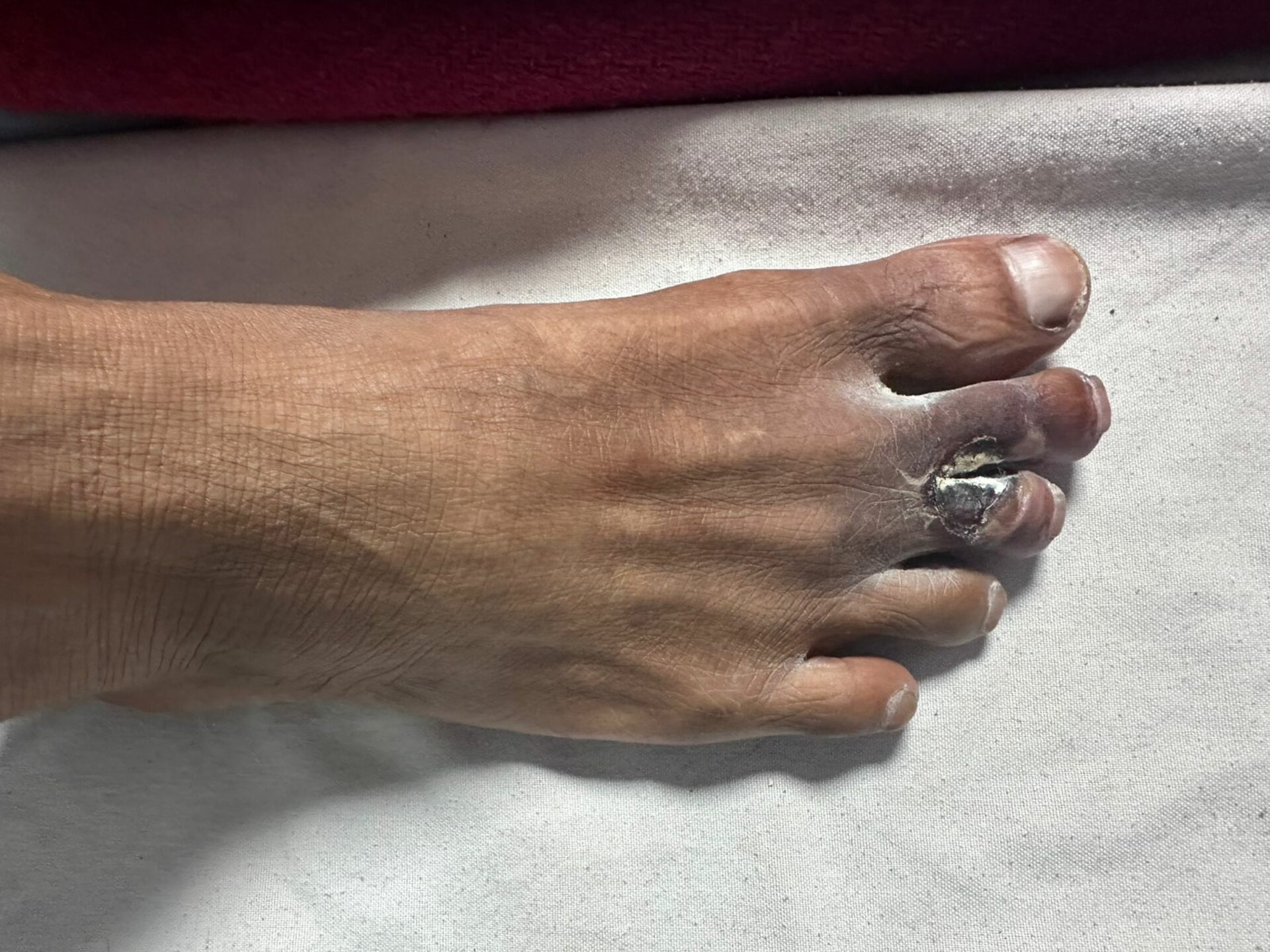A 65 - year-old male presented to the clinic with complaints of worsening leg pain, especially while walking, which had progressively limited his mobility over the past few months. Initially, the pain was intermittent and affected his right leg, forcing him to stop walking after a short distance. Over the last few days, the patient began experiencing a sudden, sharp pain in the right leg at rest, accompanied by discoloration of the toes on the right foot, raising concerns about critical limb ischemia. The pain had become severe enough to prevent him from sleeping.
Examination:
Upon physical examination, the patient’s right leg was cool to touch, with a weak peripheral pulse below the knee. His right toes showed signs of discoloration and early signs of gangrene. The ankle-brachial index (ABI) on the right side was markedly reduced, confirming severe arterial insufficiency.
Investigations:
A peripheral coronary angiogram (CAG) was performed, which revealed a long-segment stenosis of the right superficial femoral artery (SFA), consistent with thrombotic occlusion. This confirmed the source of the patient’s symptoms—severe ischemia due to inadequate blood supply to the right leg and critical ischemia of the right toes.
Treatment:
Given the urgency of the situation, peripheral angioplasty was performed by Dr. Yogesh Jamage. During the procedure, a balloon catheter was used to open the narrowed section of the superficial femoral artery, and a stent was placed to keep the artery open, allowing for improved blood flow to the affected limb.
Outcome:
Post-operatively, the patient experienced significant relief from the debilitating leg pain, and the blood supply to the right leg improved markedly. The patient’s walking ability began to recover, and his sleep quality improved as the pain subsided. However, the gangrenous changes in the toes of the right leg were closely monitored. The medical team initiated appropriate wound care and systemic anticoagulation therapy, aiming to preserve as much tissue as possible.
The patient remains under close follow-up, with gradual improvement in the condition of his right toes expected over time.
थ्रोम्बोटिक ओक्लुजन ऑफ सुपरफिशियल फेमोरल आर्टरी
65 वर्षांच्या पुरुष रुग्णाला चालताना पायात दुखत होते , गेल्या काही महिन्यांत ही वेदना फारच वाढली होती, ज्यामुळे त्याची चालण्याची क्षमता मर्यादित झाली होती. सुरुवातीला, वेदना मध्येच येत होत्या आणि त्याचा उजव्या पायावर परिणाम होत होता, ज्यामुळे त्याला थोडे अंतर चालल्यानंतर थांबावे लागत होते. गेल्या काही दिवसांपासून, रुग्णाला उजव्या पायात अचानक तीव्र वेदना जाणवू लागल्या,ज्यासोबतच उजव्या पायाच्या बोटांमध्ये काळसरपणा आणि रंग बदलल्याचे दिसून आले. हे गंभीर पायाला रक्तपुरवठा अपुऱ्या होण्याचे (इस्केमिया) लक्षण होती .वेदना इतक्या वाढल्या की पेशेंट ला रात्री झोपता येत नव्हते
तपासणी:
शारीरिक तपासणीमध्ये रुग्णाचा उजवा पाय थंड पडलेला होता आणि गुडघ्याखालच्या भागात नाडी (पल्स) कमकुवत होती. उजव्या पायाच्या बोटांमध्ये काळसरपणा आणि गँग्रीन होण्याची सुरुवात झाल्याचे दिसून आले. उजव्या बाजूचा अँकल-ब्राचियल इंडेक्स (ABI) खूप कमी झाला होता, ज्यामुळे अर्टरीमधून रक्तपुरवठा गंभीरपणे कमी झाल्याचे सिद्ध झाले.
तपास:
पेरिफेरल अँजिओग्राम (CAG) करण्यात आली ज्यामध्ये उजव्या सुपरफिशियल फेमोरल आर्टरीमध्ये long सेगमेंट स्टेनोसिस आढळले, जे थ्रोम्बोटिक ओक्लुजनशी सुसंगत होते. यामुळे रुग्णाच्या उजव्या पायातील रक्तपुरवठा अपुरा झाल्याचे स्पष्ट झाले आणि त्याचा पायातील इस्केमिया तीव्र होता.
उपचार:
परिस्थितीचे गांभीर्य लक्षात घेऊन, डॉ. योगेश जमगे यांनी पेरिफेरल अँजिओप्लास्टी केली. या प्रक्रियेत बलून कॅथेटर वापरून सुपरफिशियल फेमोरल आर्टरीतील अरुंद भाग उघडण्यात आला आणि स्टेंट घालून रक्तप्रवाह सुधारण्यासाठी त्या अर्टरीला स्थिर ठेवण्यात आले.
परिणाम:
ऑपरेशननंतर, रुग्णाची पायाची तीव्र वेदना बरीच कमी झाली, आणि उजव्या पायाचा रक्तप्रवाह लक्षणीयरीत्या सुधारला. रुग्णाच्या चालण्याच्या क्षमतेत सुधारणा झाली आणि वेदना कमी झाल्यामुळे झोपेतही फरक पडला. मात्र, उजव्या पायाच्या बोटांतील गँग्रीनच्या स्थितीवर बारीक नजर ठेवण्यात आली. जखमेची योग्य काळजी घेणे आणि रक्त पातळ करण्यासाठी औषधोपचार सुरू करण्यात आले.
रुग्ण अजूनही follow up मधे आहे, आणि उजव्या पायाच्या बोटांची स्थिती हळूहळू सुधारेल अशी अपेक्षा आहे.
